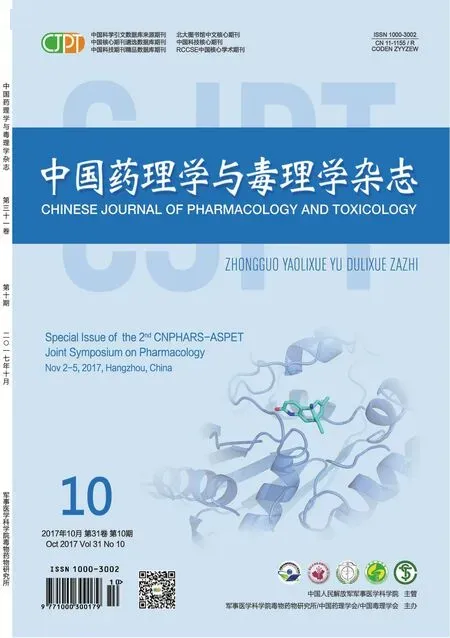Ginsenoside Rg1 attenuates motor impairment and neuroinflammation in the MPTP-probenecid-induced parkinsonism mouse model
Qian-hang SHAO,Yu-he YUAN,Nai-hong CHEN.2
(1.State Key Laboratory of Bioactive Substances and Functions of Natural Medicines,Institute of Materia Medica&Neuroscience Center,Chinese Academy of Medical Sciences and Peking Union Medical College,Beijing 100050,China;2.College of Pharmacy,Hunan University of Chinese Medicine,Changsha 410208,China)
T2-21
Ginsenoside Rg1 attenuates motor impairment and neuroinflammation in the MPTP-probenecid-induced parkinsonism mouse model
Qian-hang SHAO1,Yu-he YUAN1,Nai-hong CHEN1.2
(1.State Key Laboratory of Bioactive Substances and Functions of Natural Medicines,Institute of Materia Medica&Neuroscience Center,Chinese Academy of Medical Sciences and Peking Union Medical College,Beijing 100050,China;2.College of Pharmacy,Hunan University of Chinese Medicine,Changsha 410208,China)
OBJECTIVETo evaluate these activities of Rg1 in the 1-methyl-4-phenyl-1,2,3,6-tetrahy?dropyridine(MPTP)/probenecid(MPTP/p)-induced PD mouse model for the first time and to elucidate the underlying mechanisms.METHODSMale C57BL/6 mice were randomly assigned to six groups.One hour prior to MPTP/p injection,Group Ⅲ-Ⅵ mice
10 mg·kg-1,20 mg·kg-1,or 40 mg·kg-1Rg1 or 3 mg·kg-1selegiline,respectively,orally from D(-3)to D49.Group Ⅰ-Ⅱ mice received solvent water.Subsequently,GroupⅡ-Ⅵ mice received by injection MPTP-HCl(25 mg·kg-1bw dissolved in 0.9%saline,sc)on a 40-d schedule at intervals of 4 d between consecutive doses in combination with an adjuvant drug,probenecid(250 mg·kg-1bw in 0.03 mL of DMSO,ip);GroupⅠ mice were injected with saline and probenecid.Behavioral performance was assessed in the open field test,pole test and rotarod test.Neurotransmitters in the striatum were detected using HPLC.Protein levels were measured by Western blot.Pathological characteristics were examined by immunohistochemistry.Ultrastructure changes were observed by electron microscopy.RESULTSOral treatment with Rg1 significantly attenuated the high MPTP-induced mortality,behavior defects,loss of dopamine neurons and abnormal ultrastructure changes in the SNpc.Other assays indicated that the protective effect of Rg1 may be mediated by its anti-neuroinflammatory properties.Rg1 regulated MPTP-induced reactive astrocytes and microglia and decreased the release of cytokines such as tumor necrosis factor-α (TNF-α)and interleukin-1b(IL-1b)in the SNpc.Rg1 also alleviated the unusual MPTP induced increase in oligomeric,phosphorylated and disease-related a-synuclein in the SNpc.CONCLUSIONRg1 protects dopaminergic neurons,most likely by reducing aberrant a-synuclein-mediated neuroinflammation,and holds promise for Parkinson disease therapeutics.
Parkinson disease;neuroinflammation;a-synuclein;ginsenoside Rg1;1-methyl-4-phe?nyl-1,2,3,6-tetrahydropyridine
The project supported by National Natural Science Foundation of China(81274122,81373997,U1402221,81573640,81273629);Beijing Natural Science Foundation(7131013);Specialized Research Fund for the Doctoral Program of Higher Education of China(20121106130001);and Beijing Key Laboratory of New Drug Mechanisms and Pharmacological Evaluation Study(BZ0150)
Nai-hong CHEN,Tel:(010)63165182,E-mail:chennh@imm.ac.cn
- 中國藥理學(xué)與毒理學(xué)雜志的其它文章
- Pharmacological study on traditional Chinese medicine and natural product in China
- GPCRomics:tissue and cellular GPCR expression identifies new therapeutic targets
- Direction of new drug research:soft regulation of inflammatory immune responses
- Targeting Gprotein-coupled receptors for the treatment of autoimmune diseases
- Arrestin mediated GPCR biased signaling and its application in new drug discovery
- Identification of a novel target for cancer and anti-fibrotic therapy

